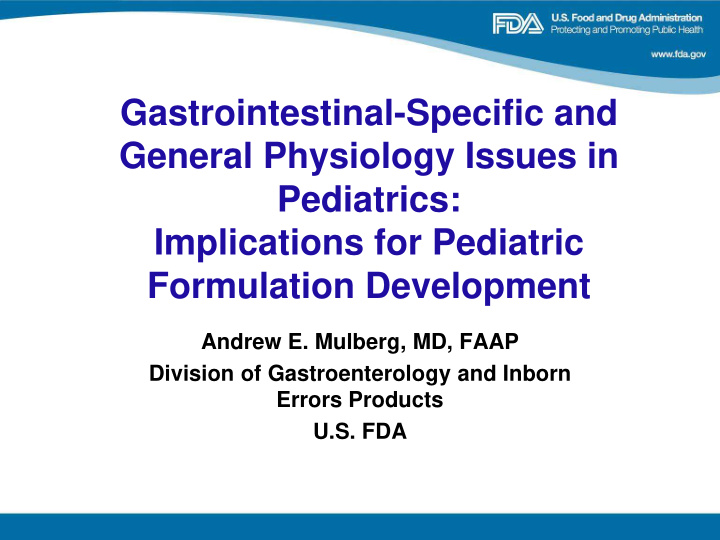



Gastrointestinal-Specific and General Physiology Issues in Pediatrics: Implications for Pediatric Formulation Development Andrew E. Mulberg, MD, FAAP Division of Gastroenterology and Inborn Errors Products U.S. FDA
Disclosure • Nothing to disclose • The views expressed in this presentation are my own and not necessarily those of the FDA 2
“ Pediatrics does not deal with miniature men and women, with reduced doses and the same class of diseases in smaller bodies, but….it has its own independent range and horizon…” Dr. Abraham Jacobi, 1889 102109 Mulberg 3
Background • There are developmental differences in infants and children that are relevant to development of pediatric formulation(s) • For example, physiological differences in gastric pH, gastric emptying, intestinal motility and ontogenic changes in general gastrointestinal physiology are relevant • GI physiological characteristics that may impact the oral bioavailability of a drug product differ due to effect of aging, ontogeny, and diseases • These issues are relevant to the development of different types of formulations 4
5
Ability to Swallow • An initial question is whether the adult formulation can be adapted for pediatric administration without compromising the integrity of the formulation • Depends on the developmental ability of a patient to swallow • Palatability of larger size formulations will often limit participation to older children (depending on tablet/capsule size) which may impact recruitment for any specific study • Pill burden 6
Formulation Factors influencing Swallowability and Esophageal Clearance • Tablet weight • Surface area • Presence and composition of coating • Disintegration time • Propensity for swelling when swallowed 7
Review of Gastrointestinal Physiology in Pediatric Patients, and in Patients with Gastrointestinal Diseases 8
Bai, Burkhart and Mulberg, Review Literature Review of Gastrointestinal Physiology in the Elderly, in Pediatric Patients, and in Patients with Gastrointestinal Diseases Journal of Pharmaceutical Sciences 2016; 105:476-483. 9
10
Fasting pH Figure 1 11
Emptying and Transit Times 12
Formulation Factors • Solubility, stability, and palatability are limiting factors for many drugs. • Masking of taste is also particularly challenging for children. The capacity to distinguish sweet and bitter is acquired very early on in life with evidence to suggest that this occurs in utero . • The affective response to odor does not appear to develop before the age of 5 years. Formulation strategies to mask taste with odor will likely be ineffective in the pre-school aged child. • The ideal oral pediatric formulation should be palatable, reliably and predictably bioavailable, and amenable to dose titration across a wide range of ages and body size. 13
Issues in Formulation Development • Pediatric specific formulations should be priority. One must consider that if the drug was not developed to be crushed or sprinkled, the stability may be impacted, the PK may be impacted, and the complete dose may not be administered. • Developmental changes potentially in factors impacting bioavailability of a formulation would impact the appropriateness of crushing/sprinkling an adult formulation. 14
Impact of food on drug exposure • In newborns, for example, the frequency with which milk-based foods are administered will likely present a drug-food interaction for compounds that share peptide transporter uptake pathways with the proteins found in milk. • Similarly, compounds that serve as substrates for the intestinal transporters inhibited by apple juice will likely demonstrate reductions in total body exposure for children permitted apple-based fruit juices ad libitum throughout the trial. 15
Impact of food on the relationship between dose and exposure • Pre-systemic clearance of selected drugs can differ considerably depending on whether an infant is breast fed or formula fed • Effect of co-administered foods and liquids cannot always be anticipated in advance; addressing established dietary issues during preclinical development (animal models, in vitro development) may help to mitigate pediatric- specific drug delivery issues at the time of trial. 16
Conclusions • Oral bioavailability of a drug product is the outcome of interaction between the patient's physiological characteristics and the characteristics of a drug product. • Demographic characteristics in infants and children share similarities in some GI physiological parameters that are relevant to drug bioavailability but differ in others from adults • Children are not small adults! • The presence of a GI diseases may increase the complexity to the drug product/GI physiology interaction and consequently influence oral bioavailability or local availability of a drug product 17
Janusz Korczak (1878-1942), a children's advocate, spoke of a Declaration of Children's Rights long before any such document was drawn up by the Geneva Convention (Korczak: 1924) or the United Nations General Assembly (Korczak: 1959) A hundred children, a hundred individuals who are people – not people- to-be, not people of tomorrow, but people now, right now – today How To Love A Child, Janusz Korczak 18
References Pediatric Drug Development: Concepts and Applications , 2 nd • edition. Mulberg AE , Murphy D, Mathis L editors. 2013. • Developmental Pharmacology —Drug Disposition, Action, and Therapy in Infants and Children. Kearns GL et al. N Engl J Med 2003;349:1157-67. • Blake MJ, Abdel-Rahman SM, Pearce RE, Leeder JS, Kearns GL. Effect of diet on the development of drug metabolism by cytochrome P-450 enzymes in healthy infants. Pediatr Res . 2006 Dec; 60 :717-23. • Bai J, Burckart G and Mulberg AE. Literature Review of Gastrointestinal Physiology in the Elderly, in Pediatric Patients, and in Patients with Gastrointestinal Diseases. J Pharmaceut Sci . 2016 105(2):476–483 • REFLECTION PAPER: FORMULATIONS OF CHOICE FOR THE PAEDIATRIC POPULATION, http://www.emea.europa.edu 19
Recommend
More recommend